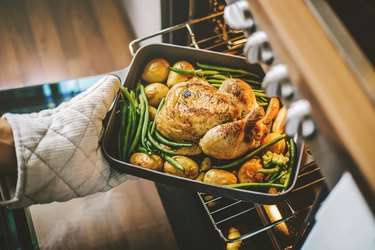
The fan oven, otherwise known as a convection oven, debuted in 1945 but did not go into commercial use until much later. Restaurants discovered that by circulating the oven's heat over, under and around the food inside, cooking times were reduced, and the amount of heat and energy used was less. Convection oven times versus regular oven times differed slightly, as food was more evenly cooked and less moisture was lost. Convection ovens migrated to home kitchen use, and they are now being used in the newest appliances, such as countertop ovens, convection microwave ovens, air fryers and even combi-steamers.
Convection Oven Temperature Conversion
Video of the Day
The general rule of thumb when calculating convection temperature is to reduce the heat setting used for a conventional oven by 25 degrees. The reverse holds true when using convection to conventional oven conversions. Increase the heat temperature setting by 25 degrees.
Video of the Day
Increase the Cooking Time
If you are baking or roasting based on the convection oven instructed length of cooking time, but you are using a conventional oven, increase the cooking time by 25 to 30 percent. A good thermometer or bamboo stick used when baking indicates the level of doneness as well. Combine both methods by increasing the length of time in the oven and a higher temperature for the best result.
The Pan Matters
When baking or roasting, use a shallow-edged pan in a convection oven. This allows the air to circulate throughout the pan. When using a conventional oven, the pan's edges are insignificant. Also, while roasting in a convection oven, you do not use a cover over the items being cooked since moisture is automatically retained via the fan heat.
Guidelines for Countertop Ovens
Just as you increase the temperature and time when converting from a convection to a regular oven, you do the same when using the countertop versions. The important factor to note is that not all food reacts with such ratios. Be sure to check your food in the regular oven at least three quarters of the way through the cooking cycle to test for doneness.
Adjusting Air Fryer Temperatures
An air fryer does not actually fry your food; it heats it via convection. Electric heat and a fan do the job of cooking. If your air fryer calls for a specific temperature, increase it by 25 percent if you are using a regular oven. Allow baked recipes to be cooked in a regular oven since air fryers don't yield the best results for this type of cooking.
Experiment With Temperatures
Convection oven times versus regular oven cooking times are merely a guideline. You must test and experiment when using the conversions. Not all ovens are equal, not all heat settings are accurate and not all food prepared with either type of oven reacts according to a recipe. Read your oven's manual first and work from there.